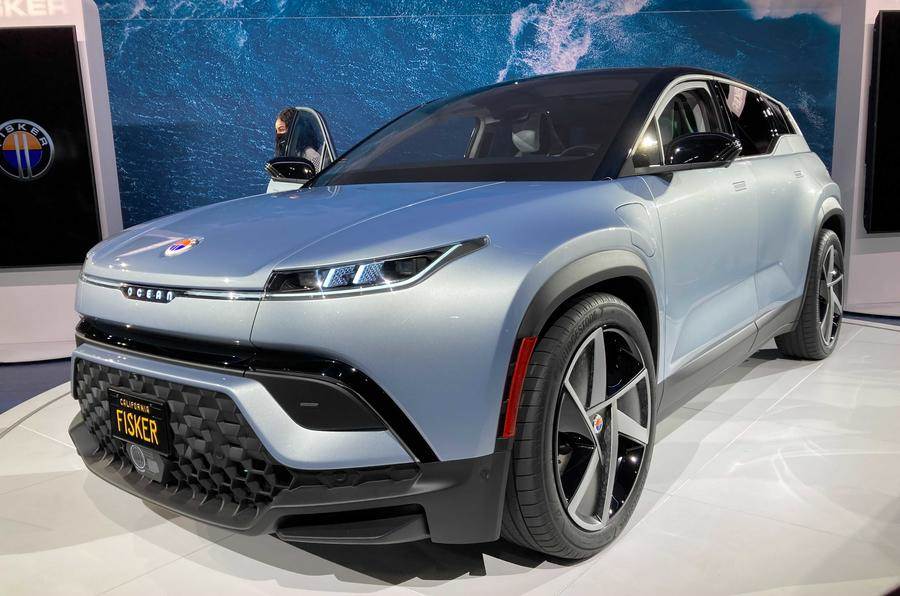The production version of the new Fisker Ocean electric SUV has been revealed at the Los Angeles motor show, a year before it goes into production for global sale.
To be produced by Magna Steyr in Graz, Austria, the Ocean will arrive in the UK in the second quarter of 2023, taking on the Audi Q4 E-tron and BMW iX3 with competitive performance figures, a raft of advanced technology and a range of up to 350 miles.
Pilot production will begin this week so that the necessary crash tests and homologation processes can get under way.
In terms of design, the Ocean stays true to the concept first shown in 2019, with Fisker committed to offering a “true SUV” rather than “yet another aerodynamic all-electric hatchback”. Its slim lights, short overhangs and a wide stance are aimed at emphasising its road presence and give heavy clues as to the design of future Fisker models.

It remains a five-seater, and the company’s commitment to sustainability extends to a “fully vegan” interior comprising reclaimed fishing nets, T-shirts and rubber. Fisker claims it’s “the world’s most sustainable electric vehicle”.
Other highlights include California mode that lowers all the windows and retracts the roof to provide a convertible-style driving experience; a Limo mode that allows rear-seat passengers to control various vehicle functions; and a rotating 17.1in infotainment touchscreen that can be switched from portrait mode to landscape mode when the car is stopped.
Three trim levels will be available. Sport brings a 275bhp motor on the front axle for a 0-60mph time of 6.6sec; Ultra gets a motor on each axle, boosting output to 540bhp and cutting the sprint time to 3.9sec; and range-topping Extreme brings 550bhp and a 3.6sec 0-60mph time.
Earth and Fun driving modes are standard in all cars, while the Ultra and Extreme add Hyper mode, which boosts performance, and the Extreme also gets a dedicated Off-Road mode.
Fisker has yet to confirm precise battery capacities but estimates a range of between 250 and 350 miles depending on specification. These are based on the US’s EPA test cycle, which often gives lower range readings than the WLTP cycle used in Europe, so European-spec cars are likely to be rated higher.
Fisker hasn’t confirmed charging capabilities either but highlights the potential of the Ocean’s solar-panel roof to add up to 2000 miles of range per year in ideal conditions.

The Ultra and Extreme variants use batteries supplied by Chinese firm CATL that use nickel-manganese-cobalt (NMC) cell chemistry, which Fisker says affords them “a combination of segment-leading range and performance”.
Company boss Henrik Fisker told Autocar UK that the batteries and powertrains were “selected this year”, only shortly ahead of the Ocean’s market launch. The reason, he explained, is that “the car industry has been in the common cycle of taking about four years to develop a car, so when you buy a car, the technology was chosen two-and-a-half or three years ago”.
He continued: “We’re trying to change that into a much shorter development time of two-and-a-half years. Part of the trick here is that we have an amazing engineering and development team, but also that we’re working really closely with Magna to produce our vehicles, because we want a high-quality vehicle, so we haven’t had to deal with building a factory and teaching people how to manufacture a car. So that’s probably an advantage and a differentiator to our business model.”
/news-international/fisker-ocean-gets-productionspec-debut-in-la-80486 Fisker Ocean gets production-spec debut in LA The production version of the new Fisker Ocean electric SUV has been revealed at the Los Angeles motor show, a year before it goes into production for global sale. https://www.autocarpro.in/Utils/ImageResizer.ashx?n=http://img.haymarketsac.in/autocarpro/84f67ef8-f072-465d-9e20-e08a18be6468.jpg
